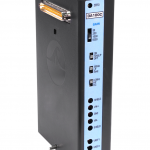The TSD221-MRI is very easy to set up, in the MRI, due to its fully MR Safe design.
- Place the respiration transducer around the body at the level of maximum respiratory expansion, generally about 5 cm below the armpits but location will vary from the erect to supine positions.
-
- To obtain proper tension, stretch the belt around the body and have the subject exhale. At maximum expiration, adjust the nylon strap so there is slight tension to hold the strap around the chest.Correct tension adjustment of the respiration transducer is important. For best sensitivity, the transducer must be just slightly tight at the point of minimum circumference (maximum expiration).
- The coupling pneumatic tube connects to the respiration sensor on the subject and should be directed through an available waveguide to terminate on the TSD160A pressure transducer attached to the DA100C in the Control Room. Measurement delay due to tubing length is 3 ms/meter.
Spotlight Application
Autonomic arousals contribute to brain fluid pulsations during sleep
Dante Picchioni, Pinar S. Özbay, Hendrik Mandelkow, Jacco A. de Zwart, Yicun Wang, Peter van Gelderen, Jeff H. Duyn,
NeuroImage, Volume 249, 2022, 118888, ISSN 1053-8119, https://doi.org/10.1016/j.neuroimage.2022.118888.
(https://www.sciencedirect.com/science/article/pii/S1053811922000180)
“Concurrently acquired peripheral physiological measures included chest belt (to monitor respiratory chest excursion) and finger skin photoplethysmography (PPG) (to monitor cardiac rate and peripheral vascular volume). These were acquired using a BIOPAC acquisition system with TSD200-MRI and TSD221-MRI transducers, and an MP150 digitizer sampling at 1 kHz (BIOPAC, Goleta, CA, USA). Data collection for both EEG and peripheral physiology were synchronized with the fMRI through a trigger signal provided by the MRI scanner.”



Stay Connected